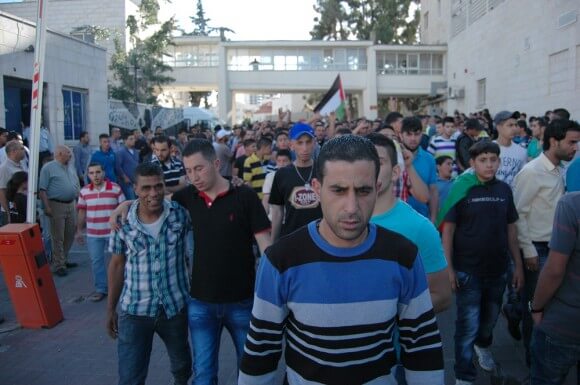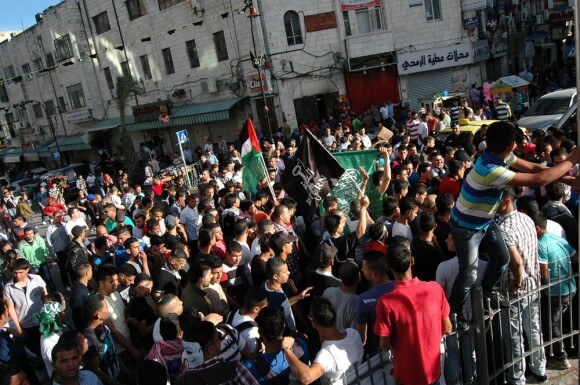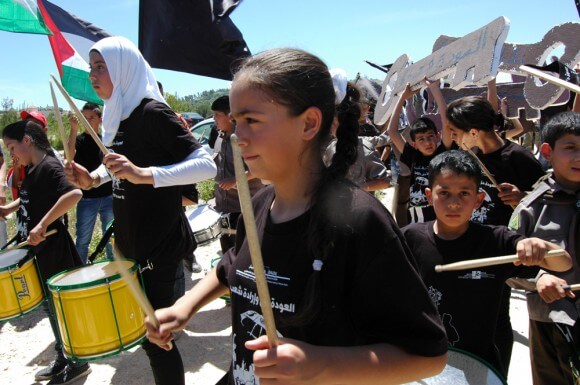
Two Palestinians were killed and a third is in critical condition after being shot by the Israeli military outside of Ofer prison in the West Bank at an annual Nakba Day protest. The youths were struck with live-fire and nine others critically wounded, according to hospital staff. The Nakba (literally “catastrophe”) refers to the 1947-49 expulsion of over 750,000 Palestinians who were forcibly evicted or fled from their villages, thus creating a refugee population that today has reached seven million.
Nadime Siam Abu Nuwara, 17, from Mazra’a Qabiya was shot by a single bullet to the heart at 12:30 pm. Mohammed Awad Salemeh Abu Thaher, 22, from Abu Khadem was killed just before 2:00 pm from a bullet to the lower abdomen. Mohammed Azza, 22, from Sharaeh was taken to an intensive care unit after being shot in the chest.
“The bullet went in and out,” said Ahmad Naser, 27, an emergency medical responder with Physicians for Palestine, pointing to his heart and back. Naser carried Abu Nuwara into an ambulance after the protesters removed him from the street while Israeli soldiers continued to fire, he said. He died in an ambulance en route to Ramallah.
During the demonstration the Israeli army also fired tear gas, rubber bullets, and sound grenades. The military also used a bulldozer to uproot seven old-growth olive trees to create a pathway for army Jeeps. Emergency medical staff said the youths threw stones at the Israeli forces.

At the hospital around 300 Palestinians poured into the plaza of Ramallah’s public hospital. Two more injured Palestinians were rushed from stretchers into the emergency room. By 7:00 pm nine others had been shot with live-fire said a doctor, although Naser said the clashes with the Israeli army were still ongoing at the time of the publication of this article. While I spoke to Naser, he leapt to treat a female relative of one of the youths killed as she lost consciousness in the hospital’s lobby.
In the rear of the medical complex, youths gathered outside the morgue to view the bodies of the deceased. Tearful teens were with their parents. The mother of Abu Thaher was brought over by two relatives that helped her walk in grief. Once inside she wailed until exasperated and then was carried out.
Following the viewing, Palestinians marched through central Ramallah, asking shop owners to give condolences by shuttering their stores.
A second main Nakba Day march took place earlier outside of Bethlehem in the rural village of al-Walaja. Two hundred marched from the town’s edge towards an Israeli military road. The Israeli army fired tear gas and sound grenades. The youths also threw stones at the army.

In 1948 all of al-Walaja’s residents were forcibly evicted from their original village, now inside of Israel. They resettled on their agricultural land two kilometers away, which is presently in the West Bank. Some became refugees in nearby camps around Jerusalem and Bethlehem.
Since the 1948 Nakba, the village has suffered a series of additional expropriations for Israeli settlement growth and military outposts. The inhabitants now face a “secondary displacement,” characterized by post-Oslo planning that is under full Israeli control, said Lubnah Shomali with BADIL, the Resource Center for Palestinian Residency and Refugee Rights, a Nakba commemoration coordinator. “Al-Walaja, it represents past displacement as well as current displacement so it’s a symbol of the on-going Nakba, a Nakba that is continuous—continuous forcible population transfer,” she explained.


I said 2 days ago that the goi would set about creating a reaction from the Palestinians.This would involve murder/maiming and any crime that it takes to get a violent reaction so the zionists cane reclaim their so called victimhood.
Look for more of the same in the coming weeks as Israel try,s to forestall the debate about who caused the breakdown of the so called Peace talks.It was not going Israel,s way and killing Palestinians is how Israel reacts.
Murdering swine.
great report allison. thank you for being there.
to family members and comrades of those killed by israeli occupation forces, i shudder to think what they must be going thru right now. my heart goes out to them. may the deceased rest in peace.
Shoah, Noah needs a new ark.
Tragedies like this, I believe, can be curtailed and even stopped by taking the advice of Thomas Paine who wrote in The Age of Reason, The Complete Edition that we need a revolution in religion based on our innate God-given reason and Deism. Everyone has reason. If religious people realize that God gave them reason and not religion they will finally let go of the religious violence promoting ancient “revealed”/hearsay religions and act more reasonably.
Progress! Bob Johnson
http://www.deism.com
In 2011 on Nakba Day, 15 Palestinians from Lebanon, Syria and Gaza were murdered by Israel and over 700 were injured in most part by Egyptian and Jordanian forces restraining Palestinians trying to reach the Israeli borders to demonstrate there. Nobody talks about them anymore. Among those injured was an American, Mounib al-Masri Jr., the grandson of Palestine’s richest man and close associate of Israel. The story was of course snuffed out and the public never heard of the young Masri anymore. HuffPo wrote about it at the time:
” Munib Al-Masri, an unarmed American citizen, was shot by the Israeli military on May 15 while protesting against Israel on the day Palestinians mark the Nakba — or catastrophe — of our dispossession in 1948. He is the grandson of Munib Al-Masri, the philanthropist, businessman and member of the Palestinian Legislative Council.
Symbolically, the younger Munib was at the border seeking in the liberating spirit of the Arab Spring to help Palestinians return to stolen homes and land in territory Israel pushed Palestinians out of in 1948. He was on Lebanese soil and behind an electric fence dividing the two countries when the live bullet entered his abdomen and caused explosive damage to his kidney, spleen, and even his spine. Munib now will live the rest of his life without his spleen and a kidney. So grave was his injury that doctors initially feared he would die due to blood loss. Like many of those injured that day, Munib remains in critical condition. Due to his American citizenship, his story may just be told in the United States and a handful of questions asked about what possessed an Israeli sniper to fire on unarmed peaceful demonstrators behind an electric fence in another country.
Indeed, the first of those questions was raised on June 1 when a journalist at a U.S. State Department briefing vigorously asked Deputy Department Spokesman Mark C. Toner about Munib’s injury. The official knew nothing, but said he would look into it.
As a long-time friend of Munib’s family and living in the Palestinian Diaspora myself, I am deeply pained over the harm done to him and all the other protestors. Now Munib may well face permanent physical hardship because he dared to dream of Palestinians’ right of return to homes to which many still retain keys and deeds…”
http://www.huffingtonpost.com/sari-anabtawi/post_1993_b_870408.html
This year’s Nakba Day demonstrations ended with Israel’s murder of Nadim Abu Nuwara, 17 and Mohammed Salameh Abu al-Thaher, 22. In 3 years from now, they too will be forgotten.